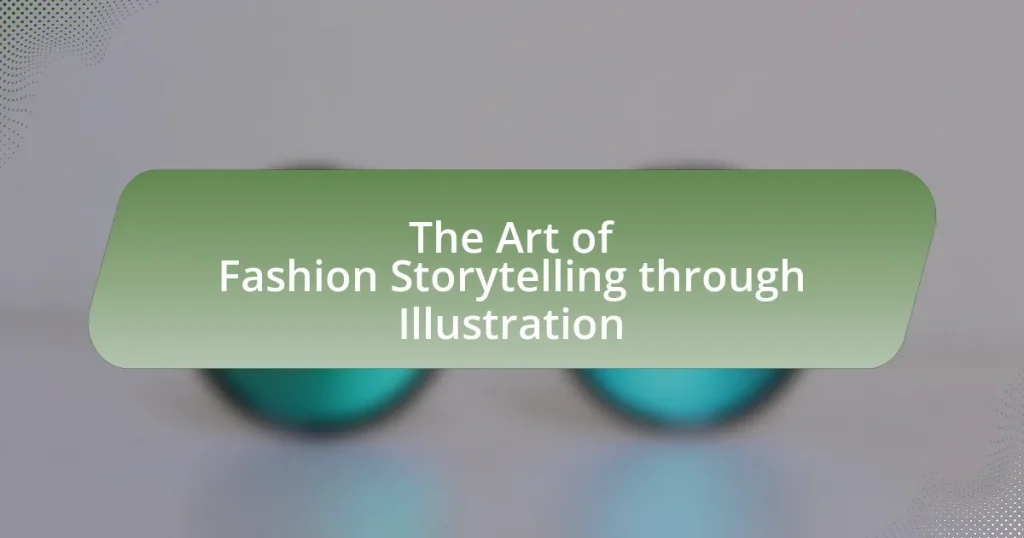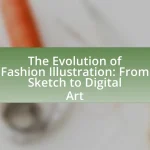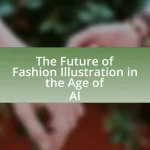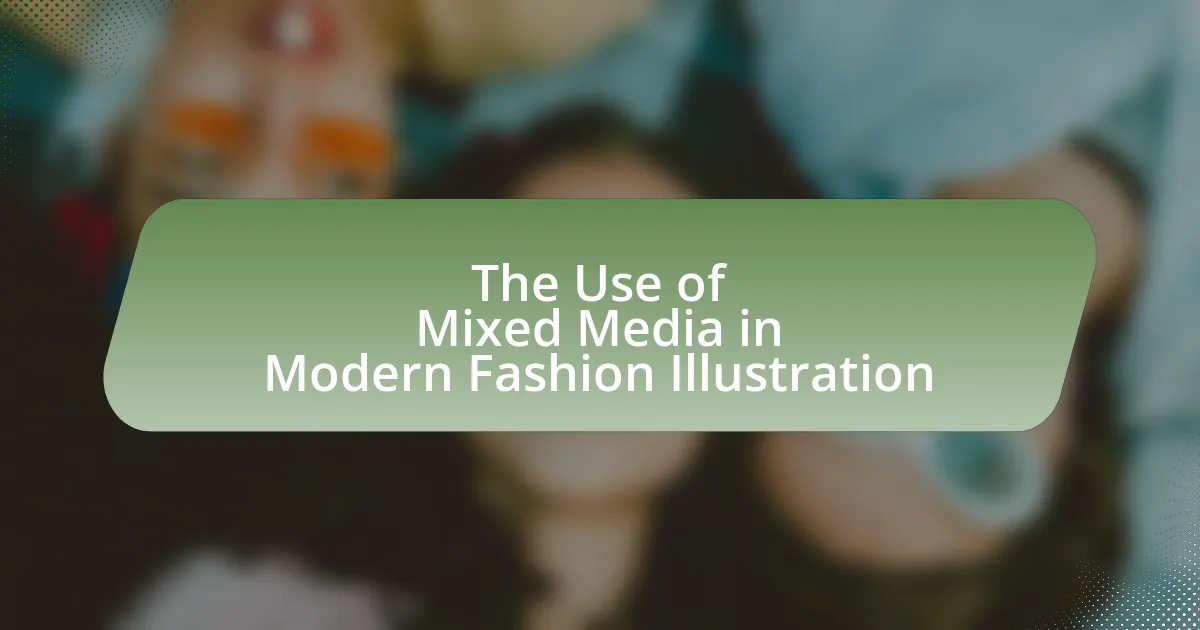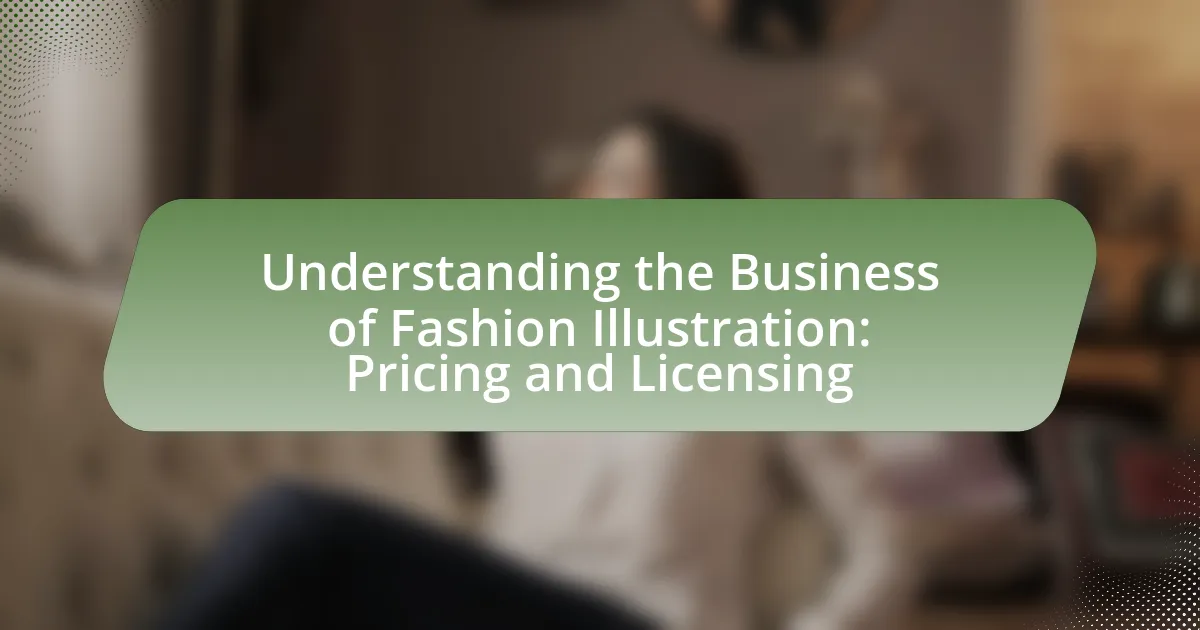The Art of Fashion Storytelling through Illustration explores the use of visual art to narrate stories about fashion, culture, and identity. It highlights how illustrators convey emotions and themes through color, composition, and character design, enhancing audience engagement and connection. The article discusses essential elements for effective storytelling, including narrative coherence and emotional resonance, as well as techniques such as visual narrative and color symbolism. Additionally, it addresses the advantages of illustration over photography, common challenges faced by illustrators, and best practices for creating impactful fashion narratives. Resources for aspiring illustrators to improve their storytelling skills are also provided.

What is the Art of Fashion Storytelling through Illustration?
The Art of Fashion Storytelling through Illustration is the practice of using visual art to convey narratives about fashion, culture, and identity. This form of storytelling allows illustrators to express emotions, concepts, and themes associated with fashion, often reflecting societal trends and personal experiences. Historical examples include the works of artists like David Downton and Megan Hess, who have successfully used illustration to capture the essence of fashion shows and designer collections, thereby influencing public perception and appreciation of fashion.
How does fashion storytelling enhance the illustration process?
Fashion storytelling enhances the illustration process by providing a narrative framework that guides the visual representation of clothing and accessories. This narrative context allows illustrators to convey emotions, themes, and cultural references, making the illustrations more engaging and meaningful. For instance, a fashion illustration that tells a story about sustainability can incorporate elements like natural landscapes or recycled materials, thus reinforcing the message visually. Research indicates that storytelling in fashion can increase audience connection and retention, as narratives evoke emotional responses that static images alone may not achieve.
What elements are essential for effective fashion storytelling in illustrations?
Effective fashion storytelling in illustrations requires a combination of visual elements, narrative coherence, and emotional resonance. Visual elements include color palettes, composition, and character design, which collectively create an engaging aesthetic that captures the viewer’s attention. Narrative coherence ensures that the illustrations convey a clear story or theme, allowing the audience to follow the progression of ideas or emotions. Emotional resonance is achieved through the portrayal of expressions, settings, and contexts that evoke feelings, making the story relatable and impactful. These elements work together to create a compelling narrative that enhances the overall effectiveness of fashion storytelling in illustrations.
How do illustrations convey emotions and narratives in fashion storytelling?
Illustrations convey emotions and narratives in fashion storytelling by visually representing concepts, moods, and themes associated with fashion. Through the use of color, composition, and stylistic choices, illustrations can evoke specific feelings, such as joy, nostalgia, or elegance, which enhances the narrative being told. For instance, warm colors may suggest warmth and comfort, while sharp lines and contrasting colors can create a sense of tension or excitement. Historical examples, such as the illustrations in Vogue magazine during the 1920s, demonstrate how artists like George Barbier used visual storytelling to reflect the cultural zeitgeist and emotional landscape of the era, effectively merging fashion with narrative art.
Why is illustration a powerful medium for fashion storytelling?
Illustration is a powerful medium for fashion storytelling because it allows for the expression of complex ideas and emotions in a visually engaging manner. Through the use of color, style, and composition, illustrations can convey narratives that resonate with audiences on a deeper level than traditional photography. For instance, renowned fashion illustrators like David Downton and Megan Hess have demonstrated how their unique artistic styles can evoke specific moods and themes, enhancing the storytelling aspect of fashion. This ability to blend artistry with narrative makes illustration an effective tool for brands to communicate their identity and vision, ultimately influencing consumer perception and engagement.
What unique advantages does illustration offer over photography in fashion storytelling?
Illustration offers unique advantages over photography in fashion storytelling by providing greater creative freedom and the ability to convey abstract concepts. Unlike photography, which captures reality, illustration allows artists to manipulate colors, forms, and styles to evoke specific emotions or themes, enhancing the narrative. For instance, illustrations can exaggerate features or create fantastical elements that reflect a designer’s vision or the mood of a collection, which is often limited in traditional photography. This flexibility enables a more personalized and imaginative representation of fashion, making it a powerful tool for storytelling in the industry.
How can illustrations capture the essence of fashion trends and styles?
Illustrations can capture the essence of fashion trends and styles by visually representing the key elements, colors, and silhouettes that define a particular period or movement. These visual depictions allow for an immediate understanding of the aesthetic and cultural context surrounding fashion, as seen in the works of illustrators like David Downton, whose sketches encapsulate the elegance and dynamism of contemporary fashion. Furthermore, illustrations can convey emotions and narratives that resonate with the audience, enhancing the storytelling aspect of fashion. For instance, the use of bold lines and vibrant colors in fashion illustrations can evoke the spirit of the 1980s, a decade characterized by flamboyant styles and cultural shifts. This ability to distill complex trends into accessible visuals makes illustrations a powerful tool in fashion communication.
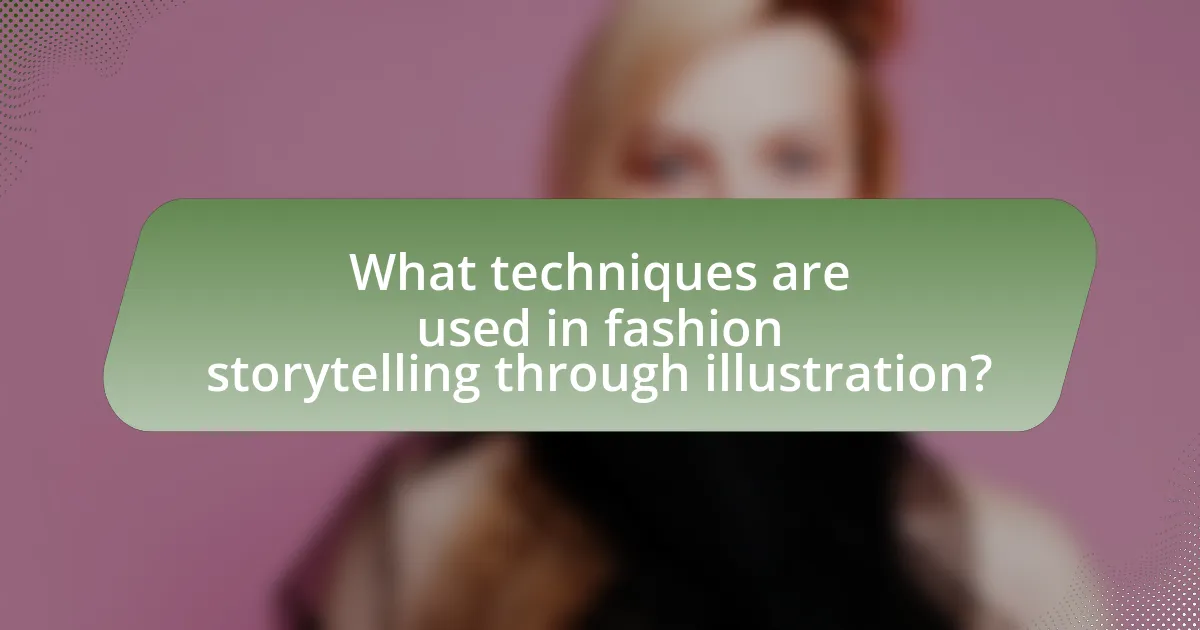
What techniques are used in fashion storytelling through illustration?
Fashion storytelling through illustration employs techniques such as visual narrative, character development, and color symbolism. Visual narrative allows illustrators to convey a story through sequential images, creating a dynamic flow that engages viewers. Character development involves designing unique figures that embody specific themes or emotions, enhancing relatability and connection to the audience. Color symbolism plays a crucial role in evoking feelings and setting the mood, as different colors can represent various concepts and cultural meanings. These techniques collectively enhance the storytelling aspect of fashion illustrations, making them not only visually appealing but also rich in narrative depth.
How do artists choose color palettes to enhance storytelling?
Artists choose color palettes to enhance storytelling by selecting hues that evoke specific emotions and themes relevant to their narrative. For instance, warm colors like reds and oranges can convey passion or urgency, while cool colors such as blues and greens often represent calmness or melancholy. This strategic use of color aligns with psychological principles; research indicates that colors can significantly influence mood and perception, as demonstrated in studies by the Institute for Color Research, which found that people make subconscious judgments about a person, environment, or product within 90 seconds, primarily based on color alone. Thus, artists intentionally curate their color choices to reinforce the emotional undertones of their illustrations, ensuring that the visual narrative resonates with the audience.
What psychological effects do colors have on fashion illustrations?
Colors in fashion illustrations evoke specific psychological responses that influence viewer perception and emotional engagement. For instance, warm colors like red and orange can create feelings of excitement and passion, while cool colors such as blue and green often evoke calmness and tranquility. Research indicates that color can significantly affect mood and behavior; for example, a study published in the journal “Color Research and Application” found that colors can impact consumer emotions and decision-making processes. This demonstrates that the strategic use of color in fashion illustrations not only enhances aesthetic appeal but also shapes the narrative and emotional resonance of the artwork.
How can color choices reflect the mood of a fashion narrative?
Color choices can significantly reflect the mood of a fashion narrative by evoking specific emotions and setting the overall tone. For instance, warm colors like red and orange often convey passion and energy, while cool colors such as blue and green can evoke calmness and tranquility. Research in color psychology indicates that colors can influence feelings and perceptions; for example, a study published in the journal “Color Research and Application” by researchers Andrew Elliot and Markus Maier found that red can enhance feelings of excitement, while blue can promote feelings of serenity. Therefore, the strategic use of color in fashion storytelling not only enhances visual appeal but also communicates deeper emotional layers within the narrative.
What role does composition play in fashion illustrations?
Composition plays a crucial role in fashion illustrations by determining how elements are arranged to convey a narrative and evoke emotion. Effective composition guides the viewer’s eye, highlights key features of the clothing, and establishes a mood that aligns with the designer’s vision. For instance, the use of balance, contrast, and focal points can enhance the storytelling aspect, making the illustration more engaging and impactful. Studies in visual perception indicate that well-composed images are more likely to capture attention and communicate messages effectively, reinforcing the importance of composition in the art of fashion illustration.
How does the arrangement of elements influence the viewer’s perception?
The arrangement of elements significantly influences the viewer’s perception by guiding their attention and shaping their emotional response. For instance, in fashion illustrations, the placement of clothing, figures, and background elements can create a narrative that evokes specific feelings or highlights particular features of the design. Research by the American Psychological Association indicates that visual hierarchy, achieved through arrangement, affects how viewers interpret and prioritize information, leading to a more engaging experience. This demonstrates that thoughtful organization of visual components can enhance storytelling in fashion illustration, making it more impactful and memorable.
What are the common compositional techniques used in fashion illustrations?
Common compositional techniques used in fashion illustrations include the use of balance, contrast, emphasis, and movement. Balance involves distributing visual weight evenly across the composition, creating harmony; for instance, symmetrical balance can be seen in illustrations where elements are mirrored. Contrast highlights differences in color, texture, or shape, drawing attention to specific areas, such as a vibrant garment against a muted background. Emphasis directs the viewer’s focus to a particular element, often achieved through size or placement, like showcasing a model’s outfit prominently. Movement guides the viewer’s eye through the illustration, often created by dynamic lines or poses, enhancing the narrative flow. These techniques are foundational in conveying the intended message and aesthetic in fashion illustrations.
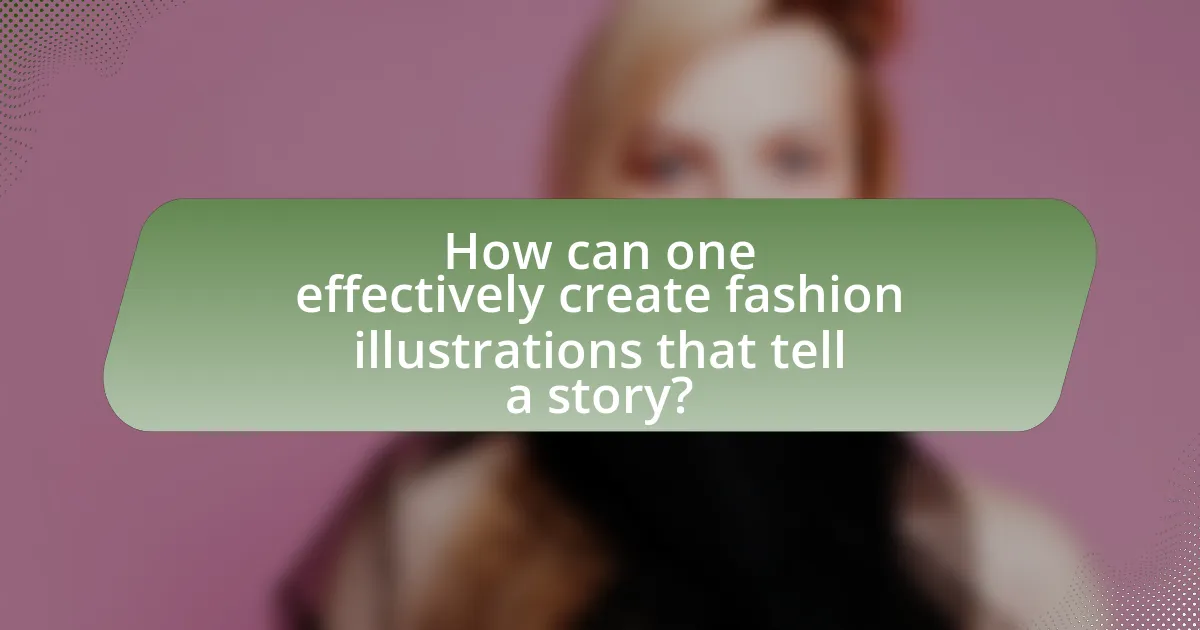
How can one effectively create fashion illustrations that tell a story?
To effectively create fashion illustrations that tell a story, an artist should focus on character development, narrative context, and visual elements. Character development involves designing figures that embody specific traits or emotions, allowing viewers to connect with the story. Narrative context can be established through the setting, which includes background elements that enhance the storyline, such as urban landscapes or natural environments. Visual elements, including color palettes, textures, and poses, should align with the mood of the narrative, reinforcing the emotional impact. For instance, a vibrant color scheme can evoke joy, while muted tones may suggest melancholy. By integrating these components, fashion illustrations can convey a cohesive story that resonates with the audience.
What steps should an illustrator follow to develop a fashion narrative?
An illustrator should follow a structured approach to develop a fashion narrative, which includes defining the concept, researching the theme, creating character profiles, sketching initial ideas, refining the visuals, and finalizing the artwork.
First, defining the concept involves identifying the core message or story the illustration will convey, which sets the foundation for the narrative. Next, researching the theme allows the illustrator to gather inspiration and understand the context, trends, and cultural references relevant to the fashion narrative.
Creating character profiles helps in developing relatable figures that embody the story, while sketching initial ideas enables the illustrator to visualize different compositions and styles. Refining the visuals involves selecting color palettes, textures, and details that enhance the narrative, and finally, finalizing the artwork ensures that all elements cohesively tell the intended story.
This structured approach is supported by the fact that successful fashion illustrations often rely on a clear narrative to engage viewers, as seen in the works of renowned illustrators who emphasize storytelling in their portfolios.
How can research and inspiration shape the storytelling process?
Research and inspiration significantly shape the storytelling process by providing a foundation of knowledge and creative stimuli that inform narrative development. Research allows storytellers to gather factual information about fashion history, cultural contexts, and design elements, which enhances authenticity and depth in their narratives. For instance, a study by the Fashion Institute of Technology highlights how understanding historical fashion trends can influence contemporary storytelling in fashion illustration. Inspiration, drawn from various sources such as art, nature, or personal experiences, fuels creativity and helps storytellers develop unique perspectives and emotional connections within their narratives. Together, research and inspiration create a rich tapestry that enhances the storytelling process in fashion illustration, ensuring that stories resonate with audiences on multiple levels.
What tools and materials are best suited for creating impactful fashion illustrations?
The best tools and materials for creating impactful fashion illustrations include high-quality sketching pencils, markers, watercolors, and digital illustration software. Sketching pencils allow for precise line work and shading, while markers provide vibrant colors and smooth application, making them ideal for fashion designs. Watercolors add a fluid and artistic touch, enhancing the visual appeal of illustrations. Digital illustration software, such as Adobe Illustrator or Procreate, offers versatility and the ability to easily edit and manipulate designs, which is essential for modern fashion illustration. These tools collectively enable artists to convey style, texture, and movement effectively, which are crucial elements in impactful fashion storytelling.
What are some common challenges faced in fashion storytelling through illustration?
Common challenges in fashion storytelling through illustration include conveying complex narratives, maintaining brand identity, and achieving visual consistency. Illustrators often struggle to encapsulate intricate fashion concepts and emotional undertones within a single image, which can dilute the intended message. Additionally, aligning illustrations with a brand’s established aesthetic is crucial; failure to do so can lead to misrepresentation. Visual consistency across various platforms and formats is also a challenge, as differing styles may confuse the audience and weaken the overall storytelling impact. These challenges highlight the need for skilled illustrators who can navigate the nuances of fashion communication effectively.
How can illustrators overcome creative blocks in their storytelling?
Illustrators can overcome creative blocks in their storytelling by employing techniques such as brainstorming, changing their environment, and seeking inspiration from various sources. Brainstorming allows illustrators to generate a multitude of ideas without judgment, facilitating the flow of creativity. Changing the environment can stimulate new thoughts; for instance, working in a different location or rearranging the workspace can provide fresh perspectives. Additionally, seeking inspiration from art, literature, or nature can reignite creativity, as exposure to diverse stimuli often leads to innovative ideas. Research indicates that engaging in these practices can significantly enhance creative output, as demonstrated in studies on creativity and environmental influences.
What strategies can be employed to maintain originality in fashion illustrations?
To maintain originality in fashion illustrations, artists should develop a unique personal style that reflects their individual perspective and experiences. This can be achieved through experimentation with various techniques, such as mixing traditional and digital media, which allows for innovative expression. Additionally, studying diverse cultural influences can inspire fresh ideas and differentiate an artist’s work from mainstream trends. Research indicates that artists who engage in continuous learning and exploration of different artistic disciplines tend to produce more original work, as seen in the practices of renowned illustrators who draw from a wide range of influences.
What best practices should illustrators follow for successful fashion storytelling?
Illustrators should focus on creating a cohesive narrative that reflects the essence of fashion storytelling. This involves understanding the brand’s identity, target audience, and the emotional tone of the collection. By incorporating elements such as color palettes, textures, and character expressions, illustrators can effectively convey the story behind the fashion pieces.
For instance, a study by the Fashion Institute of Technology highlights that visual storytelling enhances consumer engagement by 65%, emphasizing the importance of a well-crafted narrative in fashion illustration. Additionally, using dynamic poses and settings can bring garments to life, making the illustrations more relatable and impactful.
How can feedback and critique improve the storytelling aspect of illustrations?
Feedback and critique enhance the storytelling aspect of illustrations by providing diverse perspectives that identify strengths and weaknesses in visual narratives. When artists receive constructive criticism, they can refine their techniques, clarify their messages, and better engage their audience. For instance, feedback can highlight areas where the emotional tone may not align with the intended story, allowing the illustrator to adjust elements such as color, composition, or character expressions to create a more cohesive narrative. Studies in visual communication emphasize that iterative feedback loops lead to improved clarity and impact in storytelling, demonstrating that collaborative input is essential for artistic growth and effective communication in illustrations.
What resources are available for aspiring illustrators to enhance their storytelling skills?
Aspiring illustrators can enhance their storytelling skills through various resources, including online courses, books, and workshops. Online platforms like Skillshare and Coursera offer courses specifically focused on visual storytelling and illustration techniques, taught by industry professionals. Books such as “Drawing on the Right Side of the Brain” by Betty Edwards and “The Art of Storytelling” by John D. Walsh provide foundational knowledge and practical exercises to develop narrative skills. Additionally, attending workshops or conferences, such as those organized by the Society of Illustrators, allows illustrators to learn directly from experts and network with peers. These resources collectively support the development of storytelling abilities essential for effective illustration in fashion and other fields.
